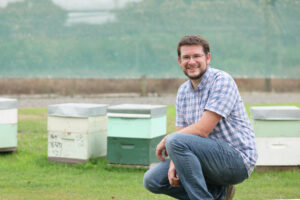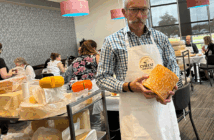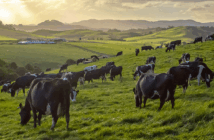
Dr David Pattemore. Copyright © Plant & Food Research. All rights reserved.
A new research article published in PLOS One has found that orchard layout and plant traits influence fruit yield more strongly than pollinator behaviour and density in a dioecious crop.
In a collaboration with researchers from the US, Plant & Food Research scientists compiled more than 30 years of field-based data from kiwifruit research to create “digital twins” of pollination processes in kiwifruit orchards. This information was then used to predict how growers can optimise their fruit set.
Acting as virtual replicas of physical systems – in this case mathematical models of the biology of the plants and the behaviours of pollinating bees – digital twins give researchers the ability to examine complex scenarios which examine multiple, intertwined factors at once. These types of trials are difficult or impossible to test in field – running a full combination of even six variables would require more kiwifruit orchards than exist in New Zealand.
Using this digital twin, the researchers predict that optimal fruit set is achieved with 60-75% female flowers in the orchard – something that growers can achieve by select pruning of male flowers. Most pollination benefit is gained from the first 6-8 honey bees/1,000 flowers, with diminishing returns thereafter. The research suggests that fruiting success is more sensitive to variation in plant traits and the female-to-male flower ratio than bee density, provided this minimum density is achieved.
“This digital twin allows us to achieve something we couldn’t have done before – simultaneous testing of the plant-based factors and the pollinator-based factors,” says Dr David Pattemore, pollination scientist at Plant & Food Research and leader of the research team.
“It now provides us with a platform to test many more questions and develop recommendations for growers that can be confirmed in field trials.”
Dr Pattemore says that the predictions obtained from the digital twin should give confidence to kiwifruit growers, and establish that what they have been practicing “is more or less on the right track”.
“The model provides strategies for improving crop management, such as selection of male and female cultivars which have their peak bloom at the same time, establishing the right balance of female to male flowers in the orchard and placing the sufficient numbers of hives to maintain more than six bees per 1,000 flowers in the orchard to optimise yield,” says Dr Pattemore.
The project is part of a wider programme to develop digital twins for pollination, using a range of different modelling approaches to investigate how different pollination factors interact and influence kiwifruit production. The researchers believe that these digital twins could potentially be used as the foundation of the development of decision support tools for growers, to guide their orchard and pollination management to optimise yields.




























































































